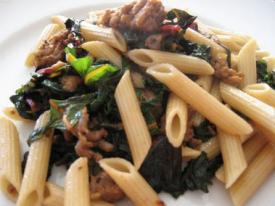Understanding Carbohydrates
- Updated: September 30, 2011

by Jerry Teixeira of Precision Nutrition Plus
 The first thing to know about carbohydrates is that they exist in most foods, and they are generally responsible for creating energy. There are, however, “good” carbs and “bad” ones. We consider carbs to be good or bad depending upon their effect on the body and their actual nutrition content.
The first thing to know about carbohydrates is that they exist in most foods, and they are generally responsible for creating energy. There are, however, “good” carbs and “bad” ones. We consider carbs to be good or bad depending upon their effect on the body and their actual nutrition content.
What do we mean by their “effect on the body”? Well, the body takes the naturally occurring sugars in carbs and converts them to energy in the form of glucose. Glucose is the only usable form of simple sugar in the body.
If the energy is not needed at the time, the body stores this in the form of fat. So, when we eat a food with carbohydrates we are creating the scenario for having energy or for building fat. How do we know which carbs to eat and which to avoid? This is actually a very simple answer; we consider the type of starch in the food and how the body will ingest it.
There are three accepted descriptions of starch or carbs and these descriptions generally look at how the food affects the body’s insulin levels, which in turn will control weight gain or loss as well as energy. There are quickly digested starches that create a sharp rise in blood sugar and over release of insulin. There are slowly digested carbs that enter the blood stream over a longer period of time, and then there are an interesting group known as “resistant” starches, which make their way to the large intestine to be processed and have no effect on blood sugar.
Basically, this all means that the higher the percentage of a quickly digested starch within a particular food, the higher the glycemic index, or GI. The GI of a food translates to the numeric value assigned to that food in relation to how quickly it affects blood glucose. For example, sugar has a GI of 100.
 Obviously all foods will have a measurable GI, and the way to understand what this means for the body is to simply note that a food with a higher GI value is likely to lead to the creation and storage of fat on the body. This is because foods with high GI values will increase the insulin level dramatically in the blood, which will transfer sugar or glucose to the liver and muscles at a faster rate than they can absorb the glucose. The excess glucose that is not absorbed by the liver or muscles then gets stored as fat.
Obviously all foods will have a measurable GI, and the way to understand what this means for the body is to simply note that a food with a higher GI value is likely to lead to the creation and storage of fat on the body. This is because foods with high GI values will increase the insulin level dramatically in the blood, which will transfer sugar or glucose to the liver and muscles at a faster rate than they can absorb the glucose. The excess glucose that is not absorbed by the liver or muscles then gets stored as fat.
This also means that choosing low GI foods will provide a longer insulin release period that delivers a nice, desirable stream of energy that can be used over a longer period of time without many concerns for fat storage. This is the reason that many athletes aim to eat a meal that offers lower GI foods a few hours before they must train or perform. This is because the long, slow burn of the glucose in the meal will give them a reliable and consistent level of energy.
What about the resistant starches? These are usually known as “fiber” and they aid the digestive process in many ways. When they reach the large intestine, they will begin to ferment and actually create beneficial bacteria and certain fats that cannot be produced anywhere else in the body. Most of the resistant starches are considered to be nonglycemic, but there are actually few foods that are entirely resistant – for example many beans are resistant to a great degree.
To understand how to identify good carbs versus bad carbs it helps to consider the amount of processing the food has undergone, and how that might affect the GI of it. For example, many whole grains that are eaten “intact” or un-ground are considered partially resistant, whereas grains that are ground into flour are highly glycemic because the processing eliminates some of the steps our bodies would have taken to digest the food. This is best seen when comparing the GI of whole wheat berries versus a slice of wheat bread. The bread, even though it is of the whole grain variety, will have a GI very close to a slice of white bread.
As stated a bit earlier, an athlete would aim to ingest a low GI meal a few hours before entering into a competition or training. The foods they would choose would have lower to intermediate GI counts. The GI index is as follows:
Low GI = below 55
Intermediate GI = 55 to 70
High GI = all foods above 70
A good example of a nice balance of GI foods for an athlete would include a heavy grain bread, one or two apples and some protein. Obviously, this indicates that the good carbs are also high in fiber and relatively unprocessed.
The bad carbs are those that are highly processed and cause the blood sugar levels to spike, which then leads to an equally rapid decline. This decline feels like an energy “crash” leaving the individual depleted of energy and also allowing them to store fat.
Some examples of high GI foods that should not be frequently consumed include, pastry, candy, refined white flour baked goods and breads, soda, and foods that are heavily laden with preservatives and artificial flavorings.
So, carbohydrates are not all bad, and someone who takes the time to assess their impact will be able to make wise choices for their own diet.
 Another example and my personal favorite pre-workout meal is as follows. I consume this meal three to two hours before my intense cardio workouts or other activities. Consuming this meal, two to three hours before to allow you body to fully digest the meal and load your body’s energy stores. It also allows your body to completely digest the meal, which demands blood for digestion to take place. With digestion, completed within those two to three hours, your body’s blood can focus on supplying your moving muscles with what they need during exercise so they can work harder and longer.
Another example and my personal favorite pre-workout meal is as follows. I consume this meal three to two hours before my intense cardio workouts or other activities. Consuming this meal, two to three hours before to allow you body to fully digest the meal and load your body’s energy stores. It also allows your body to completely digest the meal, which demands blood for digestion to take place. With digestion, completed within those two to three hours, your body’s blood can focus on supplying your moving muscles with what they need during exercise so they can work harder and longer.
The pre-workout meal I like is one serving old fashion Quaker oatmeal (use the original plan oatmeal, not the flavored stuff), one cup of blue barriers, one teaspoon or organic almond butter and one large class of water. I consume this two to three hours before intense workouts and competition.
There is a time to consume quicker digesting carbs, which is immediately following a training session or other physical activity. My next write-up will cover this.
Hope this help you with you with your carbohydrate choices.



